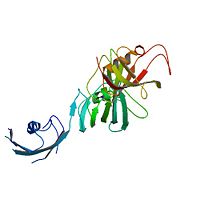Crystal Structure of the 3 FKBP domains of wheat FKBP73
(see also FK506 binding protein)
Publication Abstract from PubMed
Here we describe the crystal structure of the N-terminal domain of the FK506-binding protein (FKBP) from wheat (wFKBP73), which is the first structure presenting three FK domains (wFK73_1, wFK73_2 and wFK73_3). The crystal model includes wFK73_2 and wFK73_3 domains and only part of the wFK73_1 domain. The wFK73_1 domain is responsible for binding FK506 and for peptidyl prolyl cis/trans isomerase (PPIase) activity, while the wFK73_2 and wFK73_3 domains lack these activities. A structure-based sequence comparison demonstrated that the absence of a large enough hydrophobic pocket important for PPIase activity, and of the conserved residues necessary for drug binding in the wFK73_2 and wFK73_3 domains explains the lack of these activities in these domains. Sequence and structural comparison between the three wFKBP73 domains suggest that the wFK73_2 domain is the most divergent. A structural comparison of the FK domains of wFKBP73 with other FKBPs containing more than one FK domain, revealed that while the overall architecture of each of the three FK domains displays a typical FKBP fold, their relative arrangement in space is unique and may have important functional implications. We suggest that the existence of FKBPs with three FK domains offers additional interactive options for these plant proteins enlarging the overall regulatory functions of these proteins.
Crystal structure of the three FK506 binding protein domains of wheat FKBP73: evidence for a unique wFK73_2 domain., Unger T, Dym O, Albeck S, Jacobovitch Y, Bernehim R, Marom D, Pisanty O, Breiman A, J Struct Funct Genomics. 2010 Jun;11(2):113-23. Epub 2010 Mar 20. PMID:20306145
From MEDLINE®/PubMed®, a database of the U.S. National Library of Medicine.
Ribbon representation of the ; wFK73_1 (residues 1–148) in blueviolet, wFK73_2 (residues 149–266) in cyan and wFK73_3 (residues 267–386) in magenta (3jym). The wFK73_1 domain exhibits electron density only between residues 33–38, 54–69 and 87–148. The bulges and the flaps as well as the N- and C-termini are labeled. The three FK506 binding (FK) domains of wFKBP73 are held together mainly by situated between each pair of domains. The wFK73_2-wFK73_1 domains are held by a salt bridge between Lys162–Glu62, and a salt bridge network between Arg151–Asp61 and Glu58. The interface between wFK73_2-wFK73_3 is held by two salt bridges between Lys204–Glu269, and Glu178–Lys279. The interactions Lys162–Glu62 and Glu178–Lys279, involve conserved residues (Glu62 from wFK73_1 and Glu178 from wFK73_2, Lys162 from wFK73_2 and Lys279 from wFK73_3).
The 3D structures of several FKBP family members from various species are solved, most of them comprise 1-2 FK domains (e.g. human FKBP52), while wFKBP73 has 3 FK domains which is characteristic to plants. A sequence-based structure comparison between each of the 3 FK domains of wFKBP73 and the 2 FK domains of hFKBP52 (1q1c) was performed. All 3 FK domains of wFKBP73 adopt a typical FK fold exhibiting significant diversity when superimposed. They are arranged in a linear manner in space as observed in the 2 FK domains of hFKBP52. While the 2 FK domains of hFKBP52 are in the same orientation, the orientation between any 2 consecutive wFK73 domains is different than that between the two FK domains of hFKBP52. of the wFK73_1 (in blueviolet) and wFK73_2 (in cyan) domains on hFK52_1 (in yellow) and hFK52_2 (in blue) revealed that while wFK73_2 is perfectly aligned with hFK52_2, N-terminal wFK73_1 does not align with hFK52_1 (yellow). Similarly, of the wFK73_2 and wFK73_3 (in magenta) domains on hFKBP52 revealed that while wFK73_2 is perfectly aligned with hFK52_1 (in yellow), wFK73_3 does not align with hFK52_2. This unique arrangement of wFKBP73 causes that the α-helices of are exposed on the same surface, while the are presented on opposite surfaces.
It was shown that 12 conserved residues (for wFK73_1 domain they are Tyr67, Phe77, Asp78, Arg83, Phe87, Gln95, Val96, Ile97, Trp100, Tyr123, Ile132, and Phe140) of the FK1 domains of hFKBP12, 13, 25, 51 and 52, are involved in binding the FK506 or rapamycin. Since only the FK1 domains contain all the conserved amino acids (in contrast to FK2 and/or FK3 domains), only they exhibit PPIase activity, which can be inhibited by the binding of the drugs FK506, and rapamycin. These conserved residues form the hydrophobic cavity. The structure of hFKBP12 (2ppn) demonstrates a good example of this . All these residues are conserved in the wFK73_1 domain, it could be assumed that a similar cavity is also formed in wFK73_1, although some of these residues are missing electron density in the wFK73 structure and, therefore, it can not be seen. Domain wFK73_3 has , whereas wFK73_2 . Conserved residues are colored yellow. So, the lack of drug binding of the wFK73_2 and wFK73_3 domains could be explained by the absence of the conserved drug binding residues. This is in agreement with the fact that the FK2 domains of hFKBP51 and hFKBP52 and the single FK domains of FKBP38, DmFKBP45 and AtFKBP42, all lacking the conserved residues, do not exhibit drug binding.

